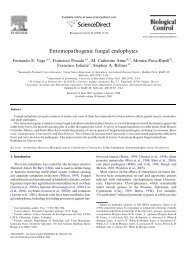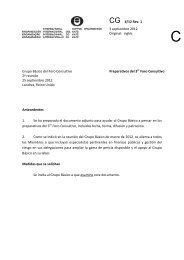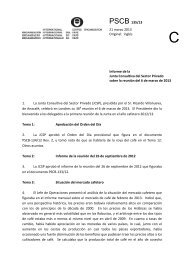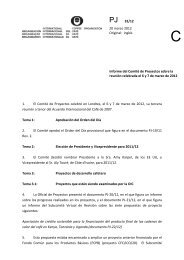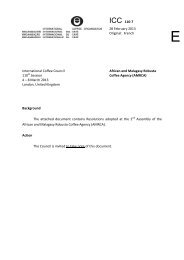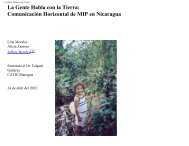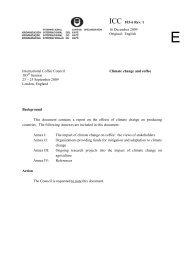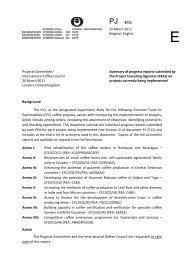Devouring profit - International Coffee Organization
Devouring profit - International Coffee Organization
Devouring profit - International Coffee Organization
You also want an ePaper? Increase the reach of your titles
YUMPU automatically turns print PDFs into web optimized ePapers that Google loves.
Indian coffee growers<br />
Farmers and size of holding: in India there are about 140,000 coffee farmers while<br />
the total area planted in this crop is about 350,000 ha; so the national average is 2.5 ha<br />
of coffee per farmer. This figure is similar to that found in other countries such as<br />
Colombia, Honduras or Mexico. Table 30 below describes the distribution pattern of<br />
holdings in different states of India (<strong>Coffee</strong> Board, 2000).<br />
Table 30. Distribution of holdings in India, by state.<br />
Size (ha) Karnataka Kerala Tamil Nadu Others Total<br />
I. Small Holdings<br />
Number of holdings in each category<br />
0-2 27,109 71,245 11,396 10,502 120,252<br />
2-4 6,580 2,995 1,246 6 10,827<br />
4-10 4,160 1,676 728 - 6,564<br />
Total<br />
II. Large Holdings<br />
37,849 75,916 13,370 10,508 137,643<br />
10-20 1,020 342 156 3 1,521<br />
20-40 445 63 49 4 561<br />
40-60 150 27 36 - 213<br />
60-80 87 19 15 - 121<br />
800-100 46 7 9 2 64<br />
Above 100 107 19 29 15 170<br />
Total 1,855 477 294 24 2,650<br />
Total India<br />
39,704 76,393 13,664 10,532 140,293<br />
From Table 30, 98% of farmers have less than 10 hectares and the 86% have 2 ha or<br />
less. It is important to understand size distribution since adoption of technologies can<br />
be affected by the farm size. Duque et al. (2000) found in Colombia that the adoption<br />
of IPM in CBB management was higher in the medium and large farmers rather than<br />
the smaller (less than 5 ha in coffee). If this is true for other coffee countries, the<br />
strategy for transferring IPM should be designed to promote good adoption levels<br />
despite socio-economic barriers. If we take the cumulative percentage of farmers and<br />
coffee areas we can quantify this as the Gini coefficient 21 (Tascon, 1980). This indicator<br />
gives a measure of land concentration, which in the case of Indian coffee has a<br />
value of 0.48, which compares to 0.57 for Colombian coffee and 0.43 for Mexico, i.e.<br />
land concentration is lower than Colombia but higher than Mexico. Land concentration<br />
can be seen from different points of view e.g. land reforms etc., but also for IPM<br />
management. Resources to dedicate to technology transfer are always limited and it is<br />
important for planning purposes to understand both the distribution of land and the<br />
relative contribution to total coffee production. Smallholders in India account for 60%<br />
of the area under coffee (Table 31), which is very significant. Hence even if large<br />
producers are more productive, coffee smallholders in India constitute an important<br />
sector, not only for social reasons but from economic and environmental standpoints<br />
as well.<br />
21 If Gini coefficient equals 1, there is total land concentration (one person owns all<br />
the land); if it equals 0, everyone has an equal area.<br />
85




